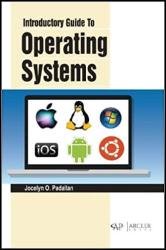Introductory Guide to Operating Systems
- Добавил: literator
- Дата: 26-05-2023, 16:07
- Комментариев: 0
 Название: Introductory Guide to Operating Systems
Название: Introductory Guide to Operating SystemsАвтор: Jocelyn O. Padallan
Издательство: Arcler Press
Год: 2023
Страниц: 281
Язык: английский
Формат: pdf (true)
Размер: 10.2 MB
An operating system (OS) consists of programs that regulate the implementation of application programs, and serving as a go between of the client and PC hardware. The operating system manages the computer hardware systems well as giving a structure for applications to run. A few examples referenced in the volume are: Windows, Windows/NT, Linux, OS/2 and MacOS. The volume presents OS as advantageous and simple to use for the client, and makes handling client issues simpler. For a PC to begin running-for example, when it is organized or rebooted-it must have a primary program to run. This core system, or bootstrap program, will in general be straightforward. Normally, it is put in read-only memory (ROM) or digitally erasable read-only memory (EEPROM), referred by overall term firmware, inside the PC equipment. It launches all parts of the framework, from CPU catalogs to device regulators to memory elements.
For a PC to begin running, for example, when it is organized or rebooted, it must have a primary program. This core system, or bootstrap program, will, in general, be straightforward. It launches all parts of the framework, from CPU catalogs to device regulators to memory elements. Normally, it is put in read-only memory (ROM) or digitally erasable read-only memory (EEPROM), referred by the overall term firmware, inside the PC equipment.
In multiprogramming systems, the OS determines which cycle gets the processor and the duration. This capacity is known as process planning. The volume discusses an operating system for doing these activities:
• keeps check of processor and process status of interaction;
• allocates the processor (CPU) to a function; and
• de-assigns processors whenever a cycle is not generally needed.
The operating system (OS) is a connection point between a PC client and PC equipment. The working framework is a product that plays out every one of the fundamental errands, including file management, memory administration, process administration, managing input and output, and handling peripheral instruments, for example, printers and disk drives. A few well-known Operating Systems incorporate Windows Operating System, Linux Operating System, VMS, OS/400, AIX, z/OS, and so forth. The operating system functions as a point of interaction between the client and the PC equipment and controls the execution of a wide range of programs. A few key subjects captured in this volume incorporate:
• memory management;
• processor management;
• security;
• control over structural output;
• device management;
• file management;
• fault detecting aids; and
• synchronization between other programs and clients.
Скачать Introductory Guide to Operating Systems
[related-news] [/related-news]
Внимание
Уважаемый посетитель, Вы зашли на сайт как незарегистрированный пользователь.
Мы рекомендуем Вам зарегистрироваться либо войти на сайт под своим именем.
Уважаемый посетитель, Вы зашли на сайт как незарегистрированный пользователь.
Мы рекомендуем Вам зарегистрироваться либо войти на сайт под своим именем.
